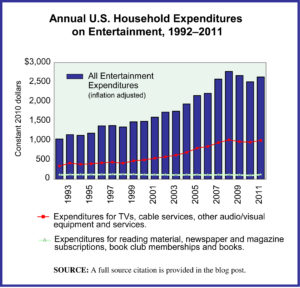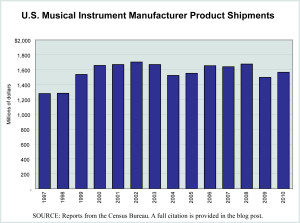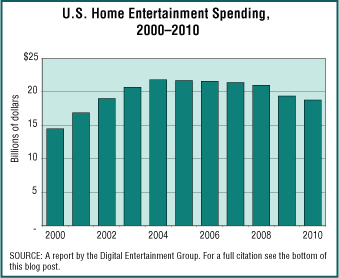
Year: 2006, 2013, and 2020
Market size: $15.7 million, $210.7 million, and $619.6 million, respectively
For much of the 20th century, vinyl records dominated the recorded music industry. The first commercially-available long-playing vinyl record was introduced by RCA Victor in 1930. Even when other forms of recorded music were available in the 1970s, vinyl still held a majority of the market. In 1975, LP/EP sales accounted for 62.2% of sales, with vinyl singles garnering another 8.9% of the market. In the 1980s, as cassette tapes became more popular and compact discs (CDs) were introduced, sales of vinyl records plummeted from 71.1% of sales in 1980 to 8.8% of sales in 1989.
Cassette tapes, introduced in the 1960s, offered music aficionados portability and durability. Consumers could record their favorite music from the radio to create on-the-go playlists and custom mixtapes. In 1983, the first CD players were sold in the United States. Initially few albums were released on the format and players retailed for $1,000; however, by 1988 CDs were so popular they outsold vinyl albums. CDs would go on to outsell cassette tapes in 1991.
Vinyl records did not completely disappear. In 1993, vinyl record sales totaled 300,000 units, or 1.6% of total recorded music sales volume and 0.1% of revenue. For much of the 1990s and early-to-mid 2000s, vinyl sales hovered around 1 million units, with peak sales of 1.5 million units sold in 2000. By 2005, CD sales in two major retail outlets were eclipsed by iTunes downloads as consumers found it more convenient and accessible to download music to their very small and portable iPods, some versions of which could store 2,000 or more songs. As popular as digital downloads were, streaming service revenue outpaced its sales by 2015. By 2018 many major retailers such as Best Buy and Target were discontinuing sales of CDs, but CDs still maintained a presence in 2020, selling 31.6 million units.
Meanwhile starting in 2006, vinyl record sales were increasing in popularity, especially among Millennials. Sales soared from 900,000 units in 2006 to 22.9 million units in 2020. Had it not been for a shortage of vinyl in 2020, sales may have gone higher. By 2020, vinyl record sales reached 5.1% of the $12.2 billion recorded music market (6.4% by volume), up from 0.1% in both revenue and volume in 2006.
What were the most popular vinyl LPs of the last decade? Abbey Road by the Beatles was number one, with 558,000 units sold between 2010 and 2019. Others in the top 8 include Dark Side of the Moon by Pink Floyd (376,000 units), Guardians of the Galaxy soundtrack (367,000), Legend by Bob Marley and the Wailers (364,000), Back to Black by Amy Winehouse (351,000), Thriller by Michael Jackson (334,000), Sgt. Pepper’s Lonely Hearts Club Band by the Beatles (313,000), and Rumours by Fleetwood Mac (304,000). For the first half of 2020, the top selling vinyl album was When We All Fall Asleep, Where Do We Go? by Billie Eilish.Note: All sales figures are for new vinyl records.
Sources: “U.S. Sales Database,” The Recording Industry Association of America, 2021 available online here; Dillon Wallace, “When Did CDs Take a Front Seat to the Cassette Tape,” Aperture available online here; Aldo Svaldi, “Victrola Has Moved HQ to Denver,” Denver Post, March 18, 2021, pp. A9 and A11; “LP/Vinyl Album Sales in the United States from 1993 to 2019,” Statista, January 8, 2021 available online here; Joshua P. Friedlander, “Year-End 2020 RIAA Revenue Statistics,” February 2021 available online here; The Vintage Record, “The History of Vinyl,” American History Now, January 27, 2014 available online here; DJ Rob, “The Skinny (Or Maybe the Fat) on Vinyl in 2020 — and the Ten Best Selling Vinyl Records of 2020 So Far…” DJRobblog.com, July 11, 2020 available online here; Paul Riismandel, “More New CDs Than Vinyl Records Were Sold in 2020, Yet Again,” Radio Survivor, March 4, 2021 available online here; Felix Richter, “Classics Dominate LP Sales in the U.S.,” Statista, August 27, 2020 available online here; Felix Richter, “The Vinyl Comeback Continues,” Statista, January 15, 2021 available online here; Felix Richter, “From Tape Deck to Tidal: 30 Years of US Music Sales,” The Wire, March 7, 2021 available online here.
Image source: AliceKeyStudio, “turntable-vinyl-sound-music-1208177,” Pixabay, February 19, 2016 available online here.


 Have you listened to music today? If you have you probably streamed it. In 2017, total U.S. music industry revenue was $8.7 billion, 65% of which came from streaming music services. Revenues from streaming services increased 217% from 2014 to 2017. The number of subscribers to paid streaming music services increased 358% during this time period, topping out at 35.3 million in 2017. Despite revenue and number of subscribers increasing, streaming music services are losing between $27 million and $426 million per year. How are musicians faring? On average, the top streaming services pay between $0.019 and $0.0007 per play in 2018. As a result, musicians need their songs streamed between 77,500 and 2.1 million times per month, depending on platform, in order to make a minimum wage.1
Have you listened to music today? If you have you probably streamed it. In 2017, total U.S. music industry revenue was $8.7 billion, 65% of which came from streaming music services. Revenues from streaming services increased 217% from 2014 to 2017. The number of subscribers to paid streaming music services increased 358% during this time period, topping out at 35.3 million in 2017. Despite revenue and number of subscribers increasing, streaming music services are losing between $27 million and $426 million per year. How are musicians faring? On average, the top streaming services pay between $0.019 and $0.0007 per play in 2018. As a result, musicians need their songs streamed between 77,500 and 2.1 million times per month, depending on platform, in order to make a minimum wage.1

